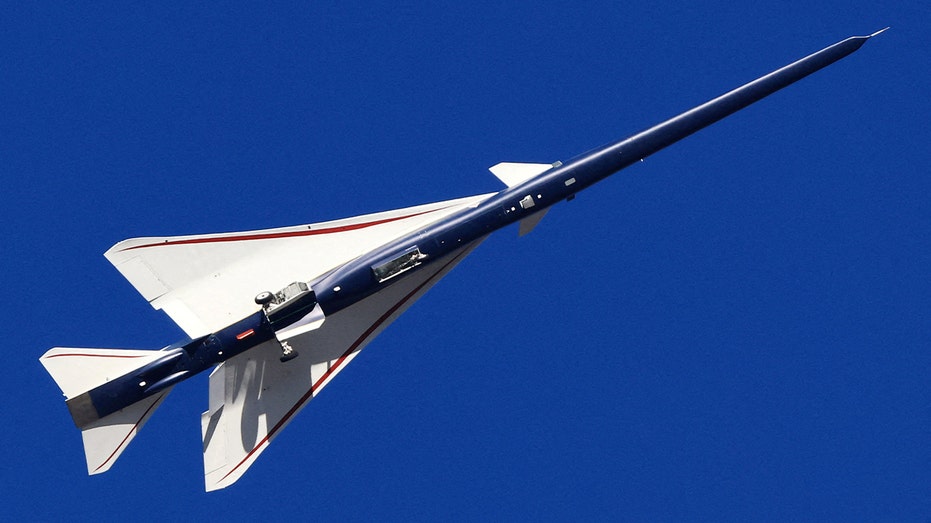SILENCE IS BROKEN: NASA's Sonic Boom REVOLUTION Takes Flight!

A new era of flight dawned this week with the successful first test flight of the X-59, a revolutionary supersonic jet designed to silence the sonic boom. Built by Lockheed Martin for NASA, this sleek, needle-nosed aircraft promises to redefine air travel as we know it. The goal: to shatter the sound barrier without shattering windows on the ground.
For decades, the disruptive roar of sonic booms has been the primary obstacle to widespread supersonic flight over land. The X-59 isn’t about eliminating the boom entirely, but reshaping it – transforming a jarring blast into a gentle “thump,” barely noticeable to those below. This single innovation could unlock a future where coast-to-coast travel takes mere hours.
The initial flight originated from Palmdale, California, at Lockheed Martin’s famed Skunk Works facility. A NASA chase plane accompanied the X-59, ensuring a watchful eye during this critical milestone. After approximately one hour, the aircraft touched down safely at NASA’s Armstrong Flight Research Center, marking a resounding success.
Its distinctive, elongated shape is the key to mitigating the sonic boom. The exceptionally long, pointed nose is a deliberate design choice, carefully engineered to disrupt the shockwaves that create the intense noise. However, this design presents a unique challenge for the pilot, who relies on monitors within the cockpit rather than direct forward visibility.
This ambitious project, representing an investment of over $500 million from NASA since 2018, isn’t just about speed. It’s about reclaiming a dream – a dream briefly realized by the Concorde, but ultimately grounded by economic and environmental concerns. The X-59 measures just under 100 feet in length and, during this first flight, cruised at subsonic speeds around 230 mph, reaching an altitude of 12,000 feet.
While the initial flight was conducted at slower speeds, the X-59 is engineered to eventually reach a cruising velocity of 925 mph – Mach 1.4 – soaring to altitudes of 55,000 feet. Imagine crossing the country in half the time, a prospect that once seemed relegated to science fiction.
The Concorde, a joint venture between France and the United Kingdom, briefly offered supersonic transatlantic travel beginning in 1976. It slashed the New York to London journey to just 3.5 hours, achieving speeds exceeding 1,300 mph. But its exorbitant operating costs – tickets were four times the price of first class – and the limitations imposed by sonic boom restrictions ultimately led to its retirement in 2003, following a tragic crash in 2000.
Now, NASA is preparing for the next phase: a series of flights over select U.S. cities. The purpose isn’t simply to demonstrate the X-59’s capabilities, but to gather crucial public feedback. This data will be instrumental in persuading regulators to revise decades-old bans on supersonic flight over land.
If successful, the X-59 could pave the way for a new generation of commercial supersonic jets, ushering in an era of dramatically faster travel. It’s a bold endeavor, fueled by American ingenuity, and a testament to the enduring human desire to push the boundaries of what’s possible – to go farther, faster, and quieter than ever before.
For decades, the disruptive roar of sonic booms has been the primary obstacle to widespread supersonic flight over land. The X-59 isn’t about eliminating the boom entirely, but reshaping it – transforming a jarring blast into a gentle “thump,” barely noticeable to those below. This single innovation could unlock a future where coast-to-coast travel takes mere hours.
The initial flight originated from Palmdale, California, at Lockheed Martin’s famed Skunk Works facility. A NASA chase plane accompanied the X-59, ensuring a watchful eye during this critical milestone. After approximately one hour, the aircraft touched down safely at NASA’s Armstrong Flight Research Center, marking a resounding success.
Its distinctive, elongated shape is the key to mitigating the sonic boom. The exceptionally long, pointed nose is a deliberate design choice, carefully engineered to disrupt the shockwaves that create the intense noise. However, this design presents a unique challenge for the pilot, who relies on monitors within the cockpit rather than direct forward visibility.
This ambitious project, representing an investment of over $500 million from NASA since 2018, isn’t just about speed. It’s about reclaiming a dream – a dream briefly realized by the Concorde, but ultimately grounded by economic and environmental concerns. The X-59 measures just under 100 feet in length and, during this first flight, cruised at subsonic speeds around 230 mph, reaching an altitude of 12,000 feet.
While the initial flight was conducted at slower speeds, the X-59 is engineered to eventually reach a cruising velocity of 925 mph – Mach 1.4 – soaring to altitudes of 55,000 feet. Imagine crossing the country in half the time, a prospect that once seemed relegated to science fiction.
The Concorde, a joint venture between France and the United Kingdom, briefly offered supersonic transatlantic travel beginning in 1976. It slashed the New York to London journey to just 3.5 hours, achieving speeds exceeding 1,300 mph. But its exorbitant operating costs – tickets were four times the price of first class – and the limitations imposed by sonic boom restrictions ultimately led to its retirement in 2003, following a tragic crash in 2000.
Now, NASA is preparing for the next phase: a series of flights over select U.S. cities. The purpose isn’t simply to demonstrate the X-59’s capabilities, but to gather crucial public feedback. This data will be instrumental in persuading regulators to revise decades-old bans on supersonic flight over land.
If successful, the X-59 could pave the way for a new generation of commercial supersonic jets, ushering in an era of dramatically faster travel. It’s a bold endeavor, fueled by American ingenuity, and a testament to the enduring human desire to push the boundaries of what’s possible – to go farther, faster, and quieter than ever before.
Share this article
Related Articles
Trending Now
Article Info
Category
Politics
Published
Oct 29, 2025
Last Updated
2 hours ago





